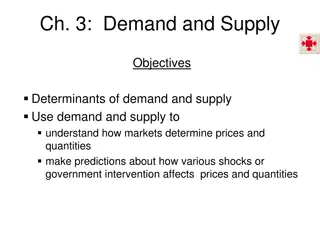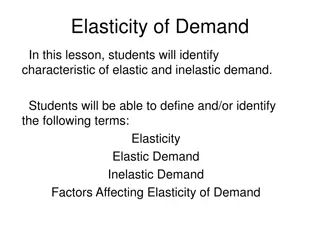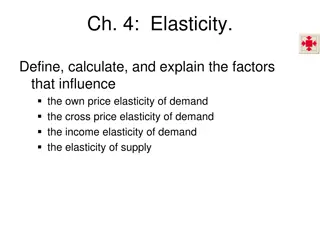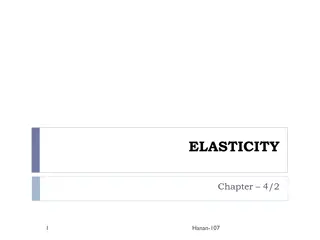Understanding Cross Elasticity of Demand in Economics
Cross Elasticity of Demand (XED) measures how the demand for one good changes in response to a change in the price of another related good. The concept is explained through examples such as close substitutes, weak substitutes, perfect substitutes, and complementary products. It helps in understanding the relationship between different products in the market.
Download Presentation

Please find below an Image/Link to download the presentation.
The content on the website is provided AS IS for your information and personal use only. It may not be sold, licensed, or shared on other websites without obtaining consent from the author. Download presentation by click this link. If you encounter any issues during the download, it is possible that the publisher has removed the file from their server.
E N D
Presentation Transcript
Cross Elasticity of Demand (XED)
Cross Elasticity of Demand (XED) Cross elasticity of demand measures the responsiveness of the demand for one good in relation to a change in the price of another. For example, if the price of Android phones (Good A)falls by10%, demand for the iPhone (Good B)may fall by 5%. The XED of Android in relation to iPhone will be +0.5. https://www.youtube.com/watch?v=8LR33paxE7I
Cross Elasticity of Substitute products Product X Product Y Month Demand (units purchased) Price per unit total Demand (units purchased) Price per unit 11 11 June July 145 196 10 10 1450 1960 147 150 1617 1650 Q2 Q1 Q1 _________ 1960 1450 1450 _________ 0.352 _________ +17.6 0.020 Py2 Py1 Py1 1650 1617 1617
Close Substitute Goods If two goods are close substitutes, there will be a high cross-elasticity of demand. Example, if the price of Sainsbury s flour increases 10%, demand for Robin Hood flour may increase 20%. To consumers, there is little difference between the two goods. Therefore, the cross elasticity of demand is +2.0
Weak Substitute Goods If goods are weak substitutes, there will be a low cross elasticity of demand. Example, if the price of The Chronicle increases 10%, the demand for the Guyana Times may only increase 1%. Therefore, the cross elasticity of demand is 0.1. These two newspapers are weak substitutes. If the price of margarine increases 10%, demand for butter may rise 2%.
Perfect Substitutes Two goods are perfect substitutes if the utility consumers get from one good is the same as another. For example a using Buckleys or Red star rubs. The satisfaction from using Buckleys Rub is very similar to using Red Star as produced by a different company. A4 paper from Office World gives same utility as A4 paper from WHSmiths. Therefore, in theory, if one good was more expensive, there would be no demand as people would buy the cheaper alternative.
Complementary Products Complementary Products: products that are sold separately but that are used together, each creating a demand for the other, for example, computers and computer p rograms. Or Cars and Gasoline Computers Computer Programs Cars Gasoline
Cross Elasticity of Complementary products Product X Product Y Month Demand (units purchased) 145 130 Price Demand (units purchased) 147 140 Price June July 1450 1300 1617 1680 Q2 Q1 Q1 _________ 130 145 145 _________ - 0.097 _________ - 0.012 63 Py2 Py1 Py1 1680 1617 1617























